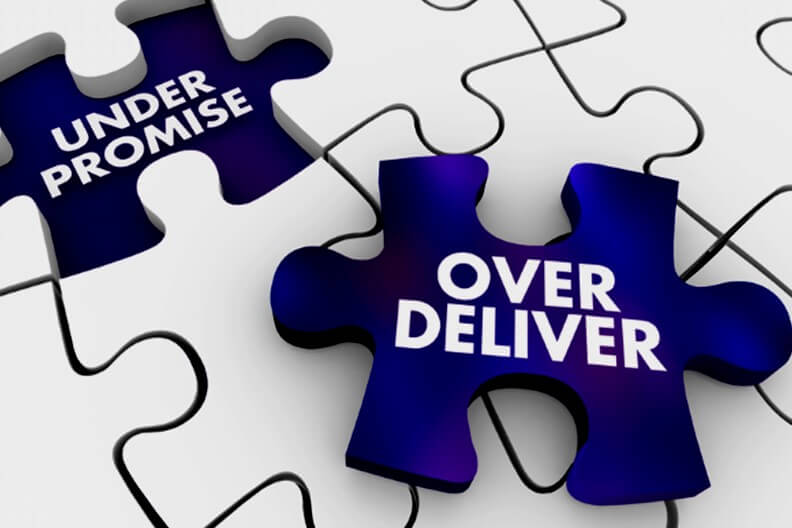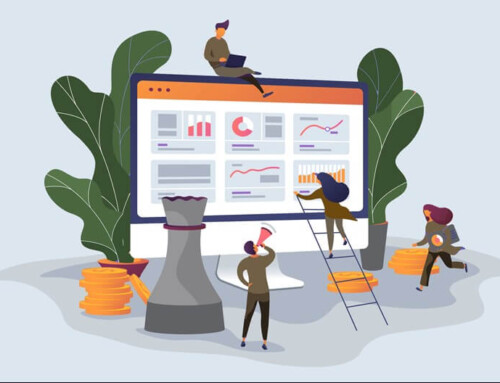Since the late 1980s, a popular strategy in the business world has been to “under-promise and over-deliver.” Its purpose is a reminder that the temptation is easy to over-promise or over-commit, but later struggle when expectations fall short. Instead, businesses are encouraged to set expectations low, do more than what was promised, and exceed expectations to result in more favorable relationships.
In theory, the value of under-promising and over-delivering sets up a business for success. Obstacles can and will happen and anticipating the “what if” scenarios mitigates the risk of both stakeholder stress and dissatisfaction. The question becomes, how does this strategy play out in the real world?
- Little impact on customer satisfaction and value
One study found that over-delivering didn’t increase customer satisfaction. When customers were asked, they indicated that they expected businesses to honor their commitments. While exceeding expectations was a nice perk, it wasn’t enough to result in loyalty or referrals. (1)
- Results in unreliable data and stakeholder conflicts of interest
When it comes to forecasting, under-promising and over-delivering take on a whole new context. For example, in 2017, Forbes highlighted case study scenarios from Procter & Gamble’s Puritan Oil brand. In the first scenario, leadership wanted to forecast growth. The under-promise and over-deliver strategy was employed. The growth forecast was underestimated by 10-15% to stay within the good graces of senior executives. As a result, growth consistently exceeded the forecast, pleasing leadership with the outcome. The second scenario involved the supply chain, where accuracy was critical. Detailed projections were provided within a +/- 5% allowance, resulting in a greater ability to meet all aspects of stakeholder needs.The result was a conflict of interest between stakeholders and a credibility issue with forecasting metrics. In other words, two different sets of numbers were provided despite the availability of actual data. Senior leadership and sales teams sought bonuses and utilized metrics that aligned with those objectives. However, the supply chain was accountable for negotiating products, ensuring the right product was available and delivered on time. If these two goals could not be met, it would impact brand reputation, credibility, customer satisfaction, employee morale, employee turnover, etc. (2)The solution, the case study concluded, was that the under-promise and over-delivery strategy created challenges that were mainly left unchecked. If organizations and their workers want to be successful, they should prioritize what is right for the business and maintain their credibility.• Establishes expectations that will be harder to meet over time
Today’s stakeholders, including customers, executive leaders, and vendor partners, have a plethora of information and data available to them. Whether it’s competitive market information, KPIs, supply chain upstream and downstream, or more, knowledge is only a few clicks away. Managing expectations early and often, and with integrity and transparency, is of far greater importance in business. When using the under-promise, over-deliver model, stakeholders will soon become accustomed to the over-delivery and expect it to continue. Furthermore, it will be amplified when a problem occurs, resulting in lower integrity, trust, and satisfaction among stakeholders. - Alludes to workplace dysfunction and fear of risk-taking
Impressing someone, whether it’s management, customers, or any other stakeholder, can result in “playing it safe.” Initially, trying to awe your boss and customers may seem like a good idea. It also means minimizing your risk for failure. However, upon closer inspection, the under-promise and over-deliver strategy is merely a vanity model where people feel good, but problems lie beneath the surface. Risk is part of growth, whether on a personal or professional level. Opportunities, both large and small, will come with some level of risk attached. Innovation, new ideas, collaboration, and so forth all carry a level of risk. When an organization has either a fear of failure (or a fear of success) or wants to impress stakeholders, it won’t take on challenges. Instead, they will do the minimally required work instead of going the extra mile. This acceptance of minimal activity can be detrimental to growth because it hinders workers from reaching their full potential. It limits innovation, the ability to tap into new markets, learn new skills, utilize new talent, or explore new ideas. More importantly, it decreases morale and stifles relationships because it doesn’t allow for anything creative, different, or thoughtful to challenge the status quo. The cost of the status quo (doing nothing) can be expensive. Those costs are always reflected in both top and bottom-line revenue. They are either increased costs in acquiring and retaining customers, top talent, or supply costs, or reductions in revenue, market share, or other essential growth factors.
The Solution
What people need to know and what organizations desperately need are employees and vendor partners who are indispensable. To meet this need, organizations must mirror the principles they expect to see in others.
- Each person needs to understand what makes their role, work, talents, or skills critical to the organization’s success. Don’t just show and tell them they are appreciated. Describe how they are appreciated to meet the needs of feeling valued and vital to the success of the organization.
- Everyone in the organization needs to articulate why their department is valuable to the organization and stakeholders, what makes your organization special and unique, and define this in a relevant way in their interactions with stakeholders.
- Approach every opportunity or possibility with a mindset of potential. Consider how something could work, how it could be implemented, and what solutions could be offered. Don’t limit potential by simply rejecting new things without exploring them first.
The solution for organizations to thrive during the “Great Resignation” is not complex. As seen in Procter & Gamble’s Puritan Oil study, the key is as simple as doing what is right for personal and organizational integrity.
By listening to employees’ needs, fears, and objectives, open and honest communication will follow, positively impacting your organization.
Discover more inspiring ideas for exciting experiences that boost morale and engage your people. Contact Gavel International for details.
_____________________________________
SOURCES:
- Gneezy, Ayelet and Epley, Nicholas. “Worth Keeping, but Not Exceeding: Asymmetric Consequences of Breaking Versus Exceeding Promises.” Social Psychological and Personality Science. May 8, 2014.
- https://www.forbes.com/sites/georgebradt/2017/08/15/why-you-should-under-promise-and-over-deliver-but-not-by-too-much/?sh=45a1070a4928
This article was last updated on June 13, 2025
- 6 Ways to Demonstrate That You Are a Contemporary Leader - July 14, 2025
- Why Hustle Culture Can Harm Sales Success – and How to Repair the Damage - June 30, 2025
- Enhance Sales Through Team-Friendly Storytelling - May 5, 2025






